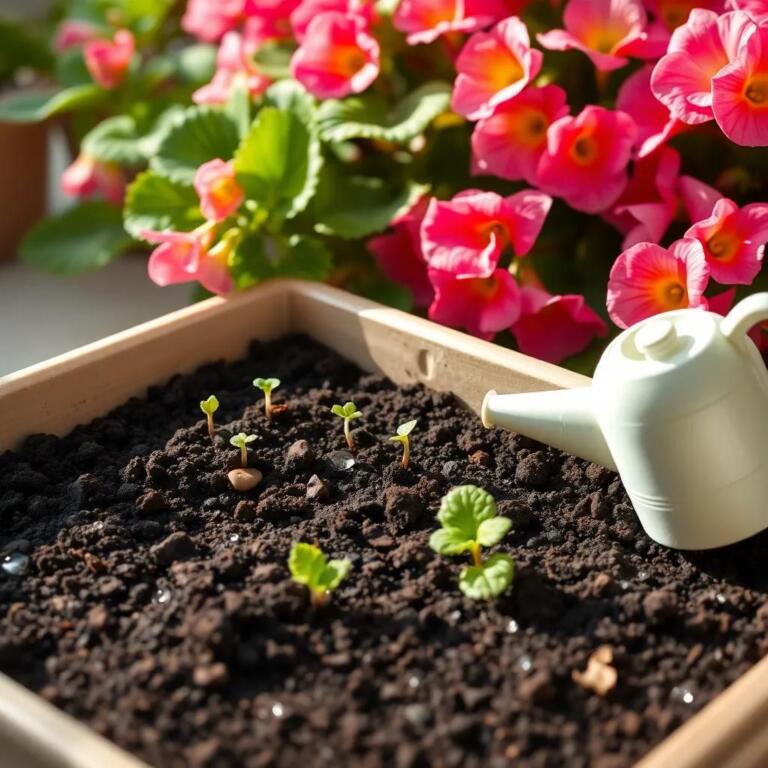Are you ready to grow your own beautiful begonias? From the moment those tiny seeds hit the soil, a magical conversion begins! Join me as we explore the fascinating world of begonia germination, and discover how to nurture your seeds into vibrant plants that will brighten any garden.
Understanding the Germination Process of Begonias
Germinating begonia seeds is like starting a little adventure in your garden! When you plant those tiny seeds, you’re not just dropping them in soil; you’re kickstarting a fascinating process that leads to beautiful plants. So, what exactly happens during germination?
First, the seed absorbs water. This is called imbibition. As the seed swells up,it breaks down stored food,which helps fuel its growth. Isn’t that cool? It’s like the seed is having a little breakfast before it gets going!
Next, the seed’s embryo begins to grow. That’s the part that will eventually become the plant! The first little root, called the radicle, pushes down into the soil. This is its way of anchoring itself, so it doesn’t float away. Meanwhile, the shoot starts to grow upwards, breaking through the soil surface. This is where the excitement happens!
Now, a few key factors can affect this process:
- Temperature: Begonias love warmth! Keeping them in a cozy range of 70-75°F (21-24°C) gives them the best chance to thrive.
- Moisture: Seeds need a bath but not a swim! The soil should be moist but not soggy. Think of it like keeping a sponge damp, not dripping wet.
- Light: Begonia seeds are photoblastic, meaning they need light to sprout. Just not too much! Indirect light is perfect for them.
By understanding this germination process, we can set our begonias up for success! With a little patience and the right conditions, those seeds will spring to life, and soon you’ll have a garden full of colorful blossoms.
Average Timeframe for Begonia Seed Germination
Now that we know how germination works, let’s talk about the waiting game! The average time for begonia seeds to germinate is typically around 10 to 20 days, but sometimes it can stretch up to 6 weeks. So, if you’re thinking about monitoring your little seeds, be prepared for a bit of a wait. It’s like watching a pot boil—so hard to be patient!
Here’s what you might expect during that time:
- First few Days: You might not see much happening. The seeds are just waking up, soaking in water, and getting ready for their big debut.
- After a Week: Tiny roots may start to poke through the soil. How exciting is that? Just be sure the soil stays moist and warm.
- By Two Weeks: You might see some leaves peeking out. That’s the shoot reaching for light, and it’s a sign that your seeds are getting comfy!
Remember, while some seeds might be sprouting like crazy, others might take their sweet time. Different begonia varieties can have different germination rates. So don’t fret if one batch is slower than the other. Keep an eye on moisture and light, and you’ll be golden!
In short, patience is key. You’re nurturing life, and that’s a beautiful thing! So grab a cup of tea, sit back, and enjoy the anticipation as you wait for those tiny green miracles to appear. 🌱

Optimal Conditions for Successful Begonia Germination
Creating the perfect surroundings for begonia seeds to germinate is like setting the stage for a grand performance! With the right conditions, your seeds will be ready to shine and flourish. Here’s what you need to know to create that ideal setup!
Temperature is a big player in this game. Begonias thrive when the temperature stays around 70-75°F (21-24°C). If it gets too cold, your seeds might just decide to snooze for a while longer. You can use a heating mat to provide some extra warmth if needed, just don’t crank it up too high!
Next up is moisture. It’s essential to keep the soil consistently damp but not soggy. Think of it like keeping a sponge wet, not dripping. A spray bottle can be your best friend here, giving just the right amount of water without flooding your seeds.
Then there’s light. Begonia seeds are photoblastic, meaning they need light to germinate, but avoid harsh, direct sunlight! Providing indirect light is key. You could place your seed trays near a window with filtered light or use a grow light for added help.
Lastly,let’s talk about humidity. Begonias love a bit of extra humidity, so consider covering the seed tray with a clear plastic lid or wrap. This will create a mini-greenhouse effect, trapping moisture while still allowing some air circulation.Just make sure to check for condensation—too much can lead to mold!
By setting these optimal conditions, you’ll have your seeds on the fast track to sprouting. The combination of warmth, moisture, and light will create a welcoming home for your future begonias!
Techniques to Accelerate Begonia Germination
So, you’re excited to see those begonia seeds sprout faster? I totally get it! Here are some fun and effective techniques to help speed up the germination process.
1. Pre-soaking the Seeds: One of my favorite tricks is to soak the seeds in lukewarm water for about 24 hours before planting. This helps soften the seed coat, allowing water to penetrate more easily. Just be sure to drain them well and pat them dry before you plant.
2. Scarification: Some begonia seeds have tough outer coats, which can slow down germination. Scarification is the process of gently nicking or scratching the seed coat. You can do this with a fine-grit sandpaper or a small knife. Just remember to be gentle—no need to go overboard!
3. Bottom Heat: Providing some gentle heat from below can work wonders. If you have a seedling heat mat, place your trays on it. This will encourage quicker root growth and help those seeds sprout faster. Just keep the temperature at a cozy level!
4. Cover with Plastic: Another neat idea is to cover your seed trays with clear plastic wrap or a humidity dome. This helps maintain warmth and moisture levels, creating a greenhouse effect. Just don’t forget to check on them regularly to prevent excess moisture buildup.
5. Use a Seedling Germination Mix: using a high-quality seedling germination mix can make a difference. These mixes are lightweight and well-draining, promoting healthy root development. They also help prevent that dreaded damping-off disease.
Combining these techniques will give your begonias an exciting head start! The anticipation of seeing those little green sprouts is truly one of the joys of gardening—a bit like waiting for a surprise gift to be unwrapped!
Common Challenges and Solutions in Begonia Germination
While germinating begonia seeds can be thrilling,it’s not always smooth sailing. Sometimes,things go a bit sideways,but fear not! Here are some common challenges you might face and how to tackle them like a pro.
1. Poor Germination Rate: If your seeds seem to be taking forever to sprout, it might be as they are old or low-quality. Always choose fresh seeds from a reputable source. if you have leftover seeds, try a germination test by placing a few on a damp paper towel to see if they’re still viable.
2. Damping-Off Disease: This pesky fungal disease can cause seedlings to collapse. To prevent this, avoid overwatering and overcrowding your trays. Always use a well-draining seed starting mix and make sure there’s good airflow around your seedlings. If damping-off occurs, remove affected seedlings instantly—don’t let them bring the others down!
3. Leggy Seedlings: If your seedlings are looking tall and spindly, they’re problably not getting enough light. Give them a boost by moving them to a brighter spot or using a grow light. Just remember, no direct sunlight yet!
4. Sticking Seed Coat: Sometimes, the seed coat can cling to the new sprout, making it hard for the seedling to grow. If this happens, gently moisten the coat with water to loosen it.Just be cautious—don’t damage that delicate little sprout!
By knowing these common issues and their solutions, you can nurture your begonias through any hiccups along the way. Gardening is all about patience, learning, and, most importantly, having fun! With a little care and attention, you’ll see those gorgeous begonias thrive, bringing joy and color to your space. Happy planting!

